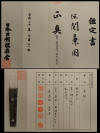
DAISHO
Exquisitely mounted Daisho (fss-409)
DAI
DEN HIOKI KANETSUGU
Shodai /1st generation
Mei: mumei
Date: keio
Nagasa : 26
1/2"
Sori: 10.5 mm
Width at the ha-machi: 27.2 mm
Width at the yokote: 18.9 mm
Thickness at the mune-machi: 6.0 mm
Construction: shinogi-zukuri
Mune: iori
Nakago: ubu
Kitae: itame/momume
Hamon: suguba
Boshi: ko-maru
Condition: polished
SHO
DEN SEKI KANEKUNI
Mei: mumei
Date: tensho
Nagasa : 18 1/2 "
Sori: 12.0 mm
Width at the ha-machi: 26.9 mm
Width at the yokote: 20.9 mm
Thickness at the mune-machi: 5.3 mm
Construction: shinogi-zukuri
Mune: iori
Nakago: ubu
Kitae: itame
Hamon: midare
Boshi: midarekomi
Condition: polished
A true Samurai Daisho, These swords are mounted in a spectacular Handachi style Koshirae of Shakudo. The Motif is of Samurai clan Mons and are in pristine condition. The mons that are used are called Paulowinia, it is a flower pattern referred to in Japanese as Go-Shichi-No-Kiri and was used to represent the Prime minister of Japan in later times.
The Dai-to was attributed to Den Kanetsugu. A beautiful blade in pristine polish and loaded with activity from the Shinshinto period. Within the Sugu-ha there is hotsure, sunagahi and kinsugi. The hada is a dense and beautiful itame and mokume mix with some masame.
The Sho-to was attributed to Den Kanekuni of the koto period. An O-suriage piece this sword has a hamon based in sugu-ha but midare-ba throughout. The hada is an itame nagare with ji-nie.
Both swords are mounted in shirasaya to protect the polish and the koshirae have tsunagi.
The wearing of daishō was limited to the samurai class, and became a symbol or badge of their rank. Daishō may have became popular around the end of the Muromachi period (1336 to 1573)as several early examples date from the late sixteenth century.An edict in 1629 defining the duties of a samurai required the wearing of a daishō when on official duty. During the Meiji period an edict was passed in 1871 abolishing the requirement of the wearing of daishō by samurai, and in 1876 the wearing of swords in public by most of Japan's population was banned; this ended the use of the daishō as the symbol of the samurai, and the samurai class was abolished soon after the sword ban.









